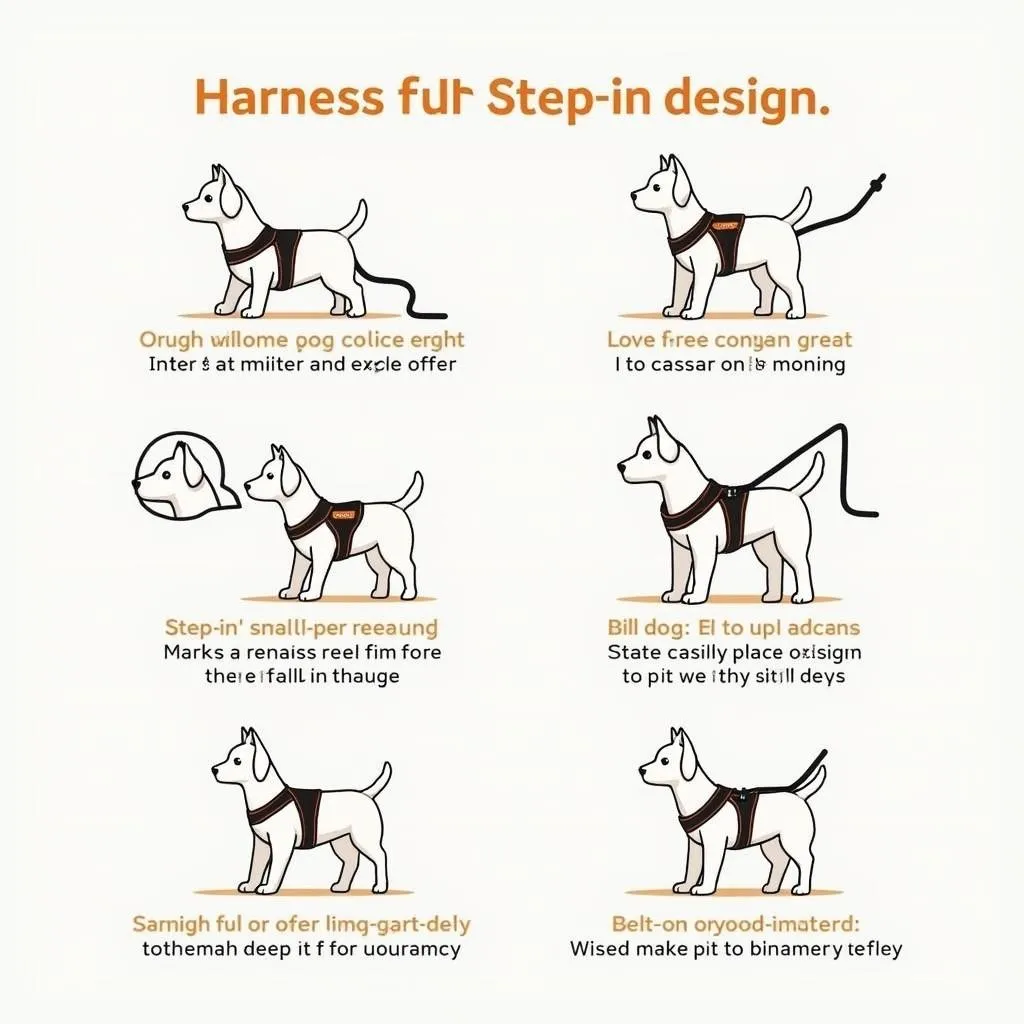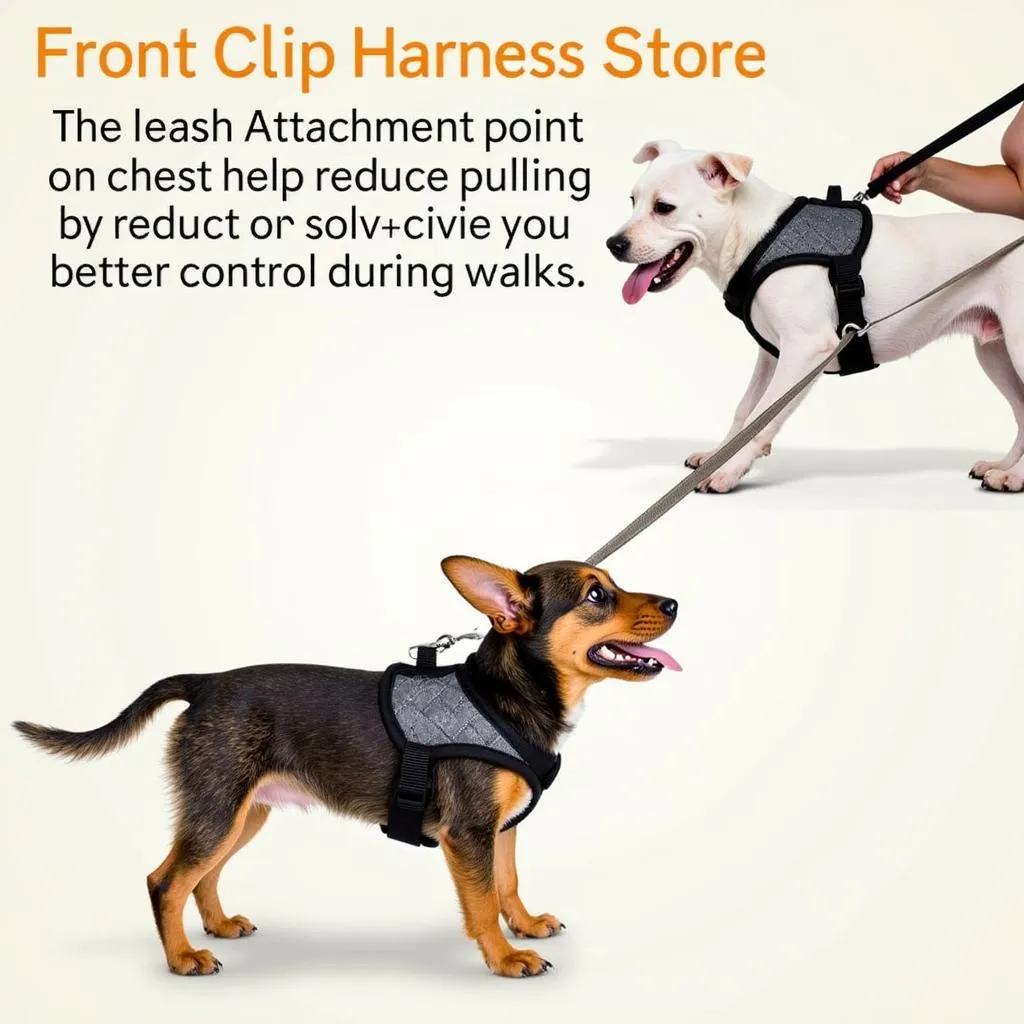“Cái răng cái tóc là gốc con người” – this Vietnamese proverb reminds us that even small details can make a big difference. When it comes to our furry friends, their harnesses and leashes are no exception! These seemingly simple accessories play a crucial role in keeping our small dogs safe and comfortable during walks and adventures.
Finding the Perfect Fit: Why Size Matters
Imagine this: You’re strolling through the park, enjoying the fresh air with your adorable chihuahua. Suddenly, a playful squirrel darts by, and your pup, excited by the chase, pulls on the leash with all its might! If your dog’s harness isn’t the right size, it could slip off, leading to a potentially dangerous situation.
That’s why choosing the right size harness and leash is crucial for small dogs. A properly fitting harness should be snug but comfortable, allowing your pup to move freely without any discomfort. A loose harness could slide around, while one that’s too tight can restrict movement and even cause injury.
Types of Harnesses: Exploring Your Options
There are several types of harnesses available for small dogs, each with its own unique features and benefits. Here’s a breakdown of the most popular options:
1. Vest Harnesses:
Think of these as the “all-rounder” of the harness world. Vest harnesses are designed to distribute pressure evenly across your dog’s chest and back, making them a great choice for pups who tend to pull on the leash.
Benefits:
- Comfort: Vest harnesses offer a comfortable fit and distribute weight evenly.
- Control: They provide excellent control, reducing pulling and making walks more enjoyable for both you and your pup.
- Safety: The full-body coverage offers additional safety, especially for small breeds.
 Small dog vest harness for walking and training
Small dog vest harness for walking and training
2. Step-in Harnesses:
These harnesses are super easy to put on and take off, simply stepping your dog’s legs into the two openings.
Benefits:
- Convenience: Quick and simple to use, making them ideal for everyday walks.
- Versatility: Suitable for a wide range of dog breeds and sizes.
 Step-in harness for easy on and off
Step-in harness for easy on and off
3. Front Clip Harnesses:
These harnesses feature a leash attachment point on the chest, rather than the back.
Benefits:
- Reduced Pulling: This design helps to discourage pulling by redirecting pressure to the dog’s chest.
- Improved Control: Provides better control, especially for dogs who tend to pull on the leash.
 Front clip harness for reduced pulling and improved control
Front clip harness for reduced pulling and improved control
Leash Considerations: Finding the Perfect Pairing
Now, let’s talk about leashes! Just like with harnesses, selecting the right leash is equally important for your small dog’s safety and comfort.
Here’s a quick guide to help you choose:
- Length: A shorter leash (around 4 feet) is generally recommended for small dogs, especially in crowded areas. This allows for better control and reduces the risk of your pup getting tangled.
- Material: Consider your dog’s personality and needs. A strong, durable nylon leash is a popular choice, while a softer, more flexible leather leash might be better suited for a more gentle dog.
- Features: Some leashes come with additional features like reflective strips for added visibility at night or a padded handle for added comfort.
Choosing the Right Harness and Leash for Your Pup: A Personalized Approach
“Every dog has its day,” they say, and that’s true for finding the perfect harness and leash combo for your pup too!
Ask yourself these questions:
- What’s my dog’s personality like? Is your pup a playful puller, a gentle soul, or a curious explorer?
- What are my dog’s specific needs? Do they need extra safety features or something easy to put on and off?
- What activities do we do together? Are you planning on going for long walks, exploring nature trails, or participating in dog training classes?
It’s also a good idea to consider your own preferences:
- What kind of control do you want? Do you prefer a harness that provides maximum control or one that allows for more freedom?
- What’s your budget? There are harnesses and leashes available at a wide range of price points.
- What style do you like? Do you prefer a classic look or something more trendy?
Tips for Choosing and Using a Harness and Leash: A Recipe for Safety and Comfort
- Professional Advice: Consult a veterinarian or a certified dog trainer for guidance on choosing the right size and type of harness and leash for your small dog.
- Try Before You Buy: Visit a pet store and try out different harnesses and leashes on your pup to ensure a comfortable and secure fit.
- Training is Key: Train your dog to wear a harness and walk on a leash safely. Start with short walks and gradually increase the distance and duration as your pup becomes more comfortable.
- Regular Inspections: Inspect your harness and leash regularly for any wear and tear. Replace them immediately if you find any damage or flaws.
FAQ: Solving Your Harness and Leash Dilemmas
Q: “What if my small dog pulls on the leash? What can I do to train them?”
A: Don’t despair! Training a dog to walk on a leash without pulling can be challenging, but it’s definitely possible. Here are some tips:
- Positive Reinforcement: Reward your dog with treats or praise whenever they walk calmly beside you.
- Focus and Engagement: Keep your dog’s attention focused on you by using treats or toys.
- Patience and Consistency: Be patient and consistent with your training. It may take time for your dog to learn.
- Professional Help: If you’re having trouble training your dog, consider consulting with a professional dog trainer.
Q: “My dog seems uncomfortable in their harness. How do I know if it’s the right size?”
A: A properly fitting harness should be snug but not tight. Here are some signs that the harness is the right size:
- You can easily slip two fingers between the harness and your dog’s chest.
- The harness doesn’t slip or slide around when your dog moves.
- Your dog doesn’t show any signs of discomfort, such as pulling back, whining, or pawing at the harness.
Q: “Is it safe for my tiny dog to wear a harness? What about their delicate bones?”
A: A well-made harness designed for small dogs shouldn’t pose any risk to their delicate bones. However, it’s crucial to choose a harness that’s specifically designed for small breeds and to make sure it fits properly.
Conclusion: Unlocking a World of Adventures with Your Small Dog
Choosing the right harness and leash for your small dog can make a world of difference in their comfort, safety, and overall enjoyment of walks and adventures. Remember to prioritize comfort, safety, and your pup’s unique personality as you explore the wide variety of options available. With a little research and the right guidance, you can find the perfect harness and leash that will keep your small dog safe and stylish on every walk.
And don’t forget, you can always reach out to us for help! Our team of pet care experts is here to answer any questions you may have and guide you in finding the best products for your furry friend.
Leave a Reply
You must be logged in to post a comment.